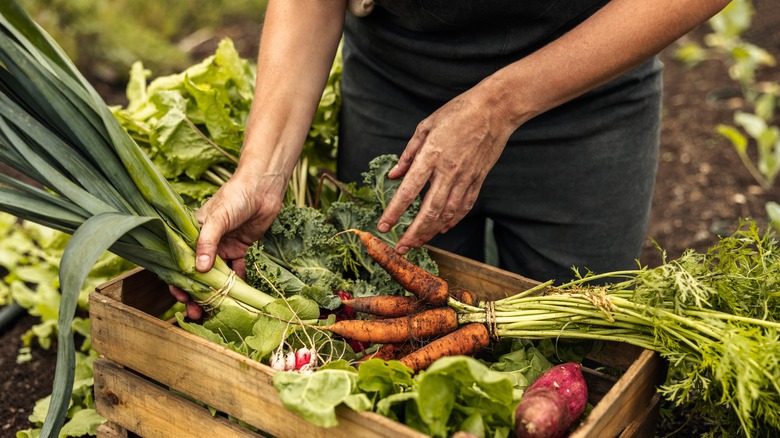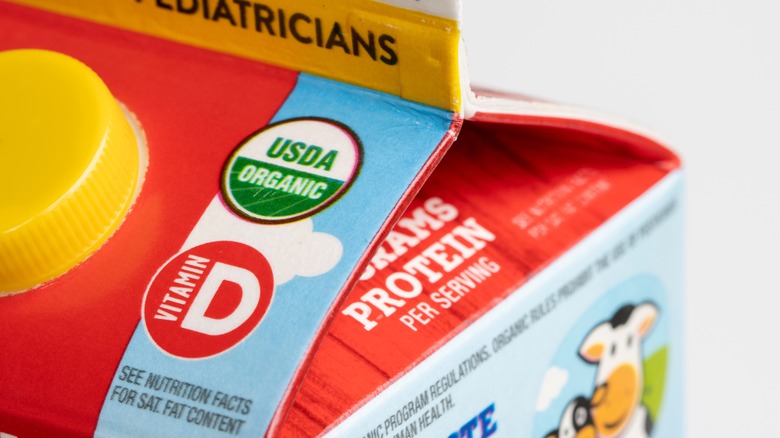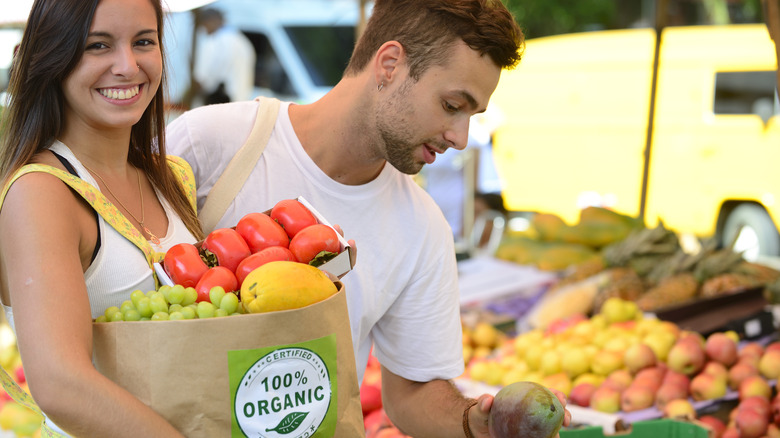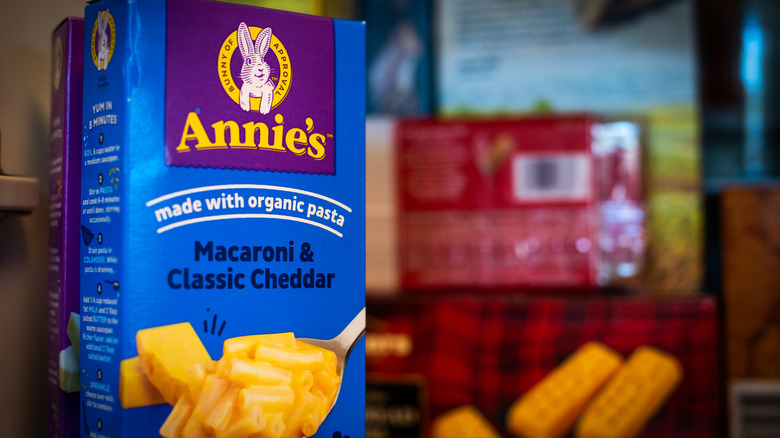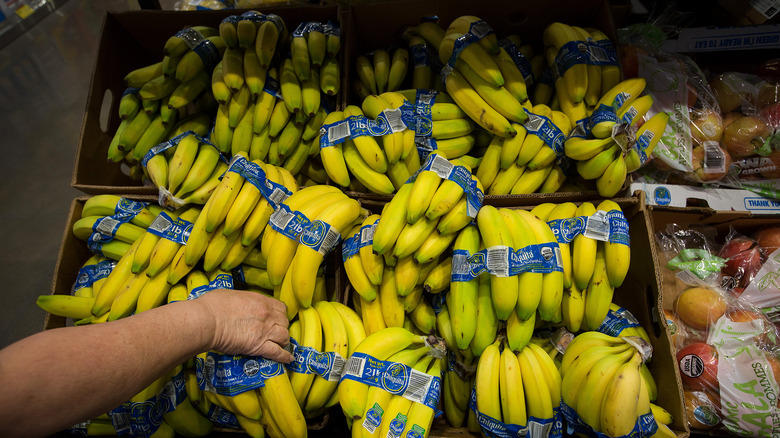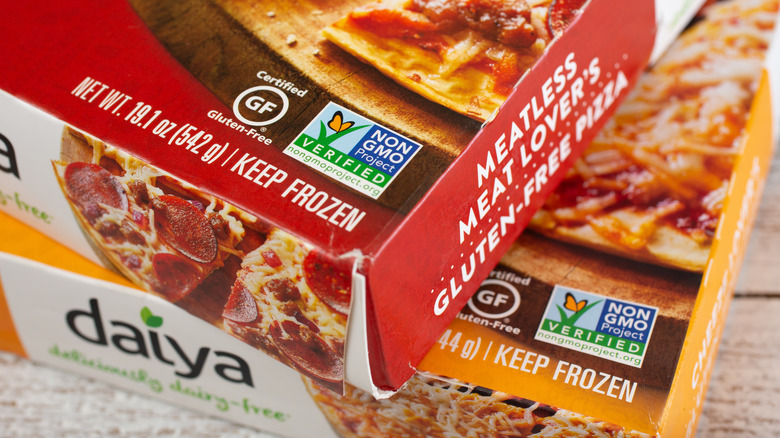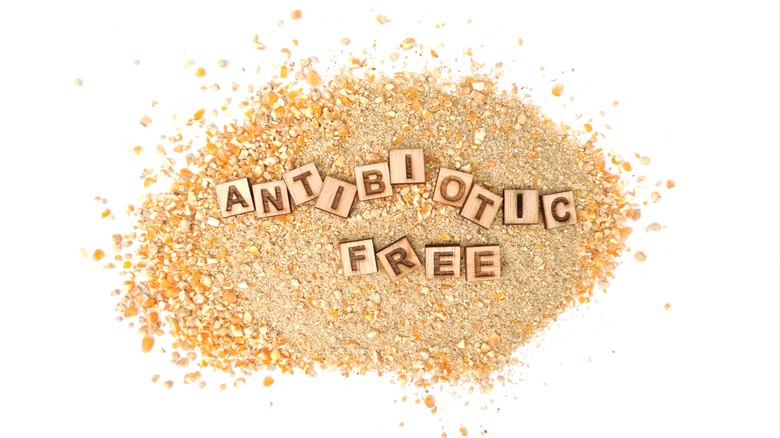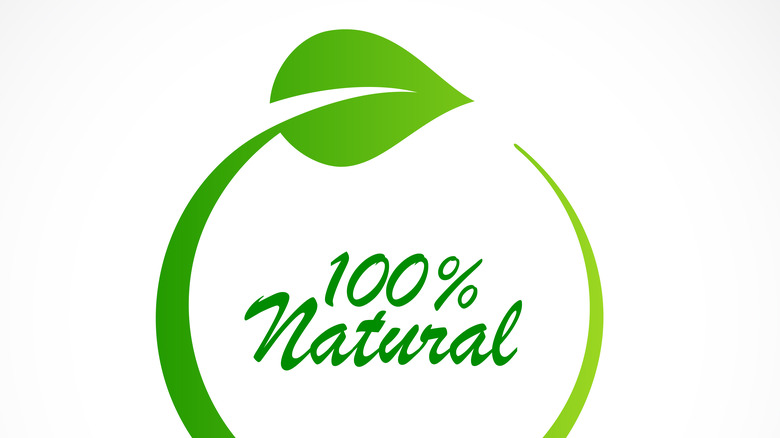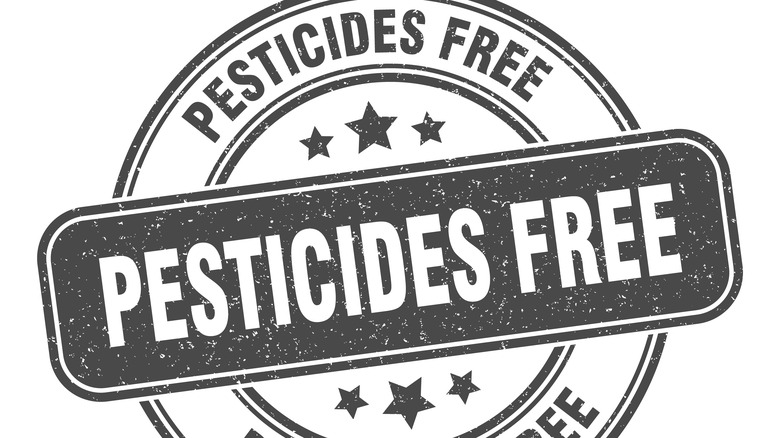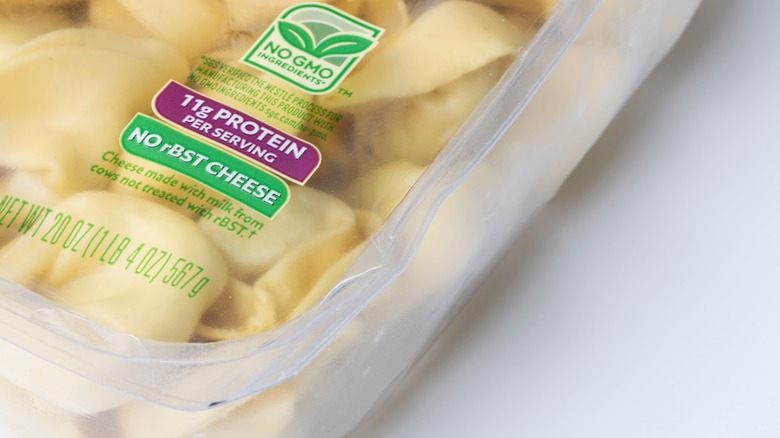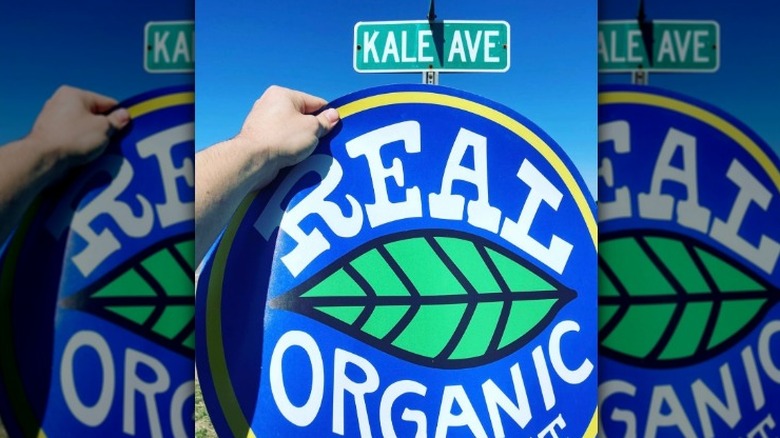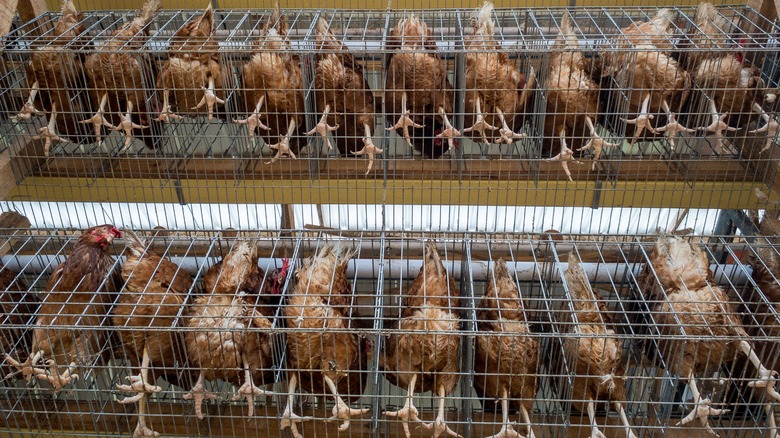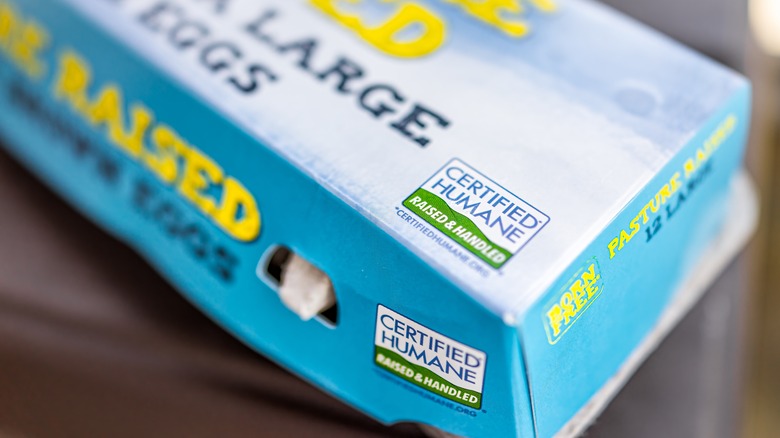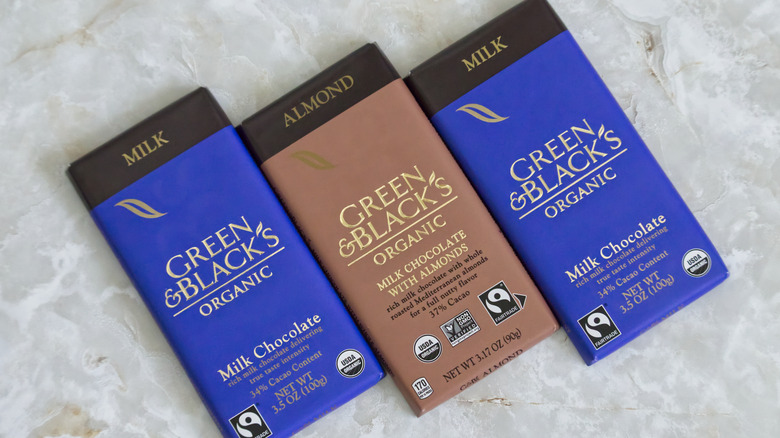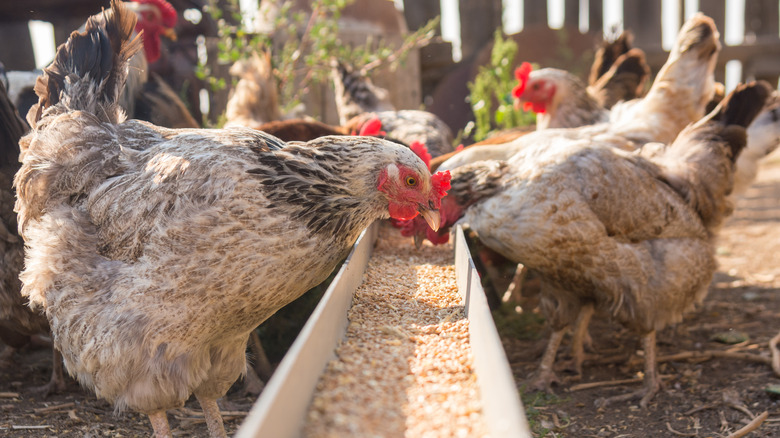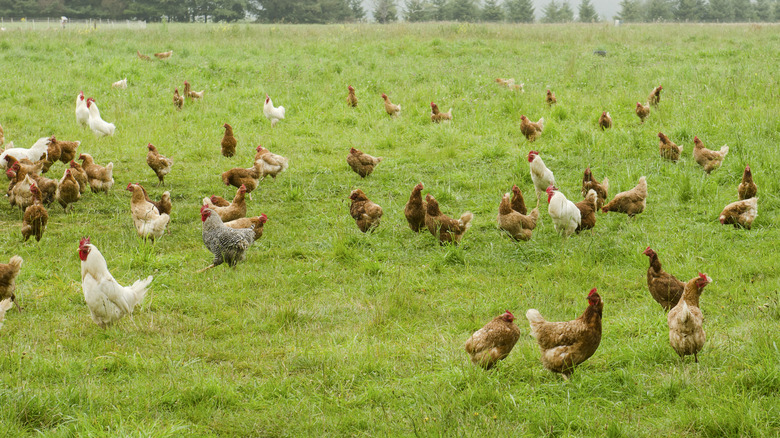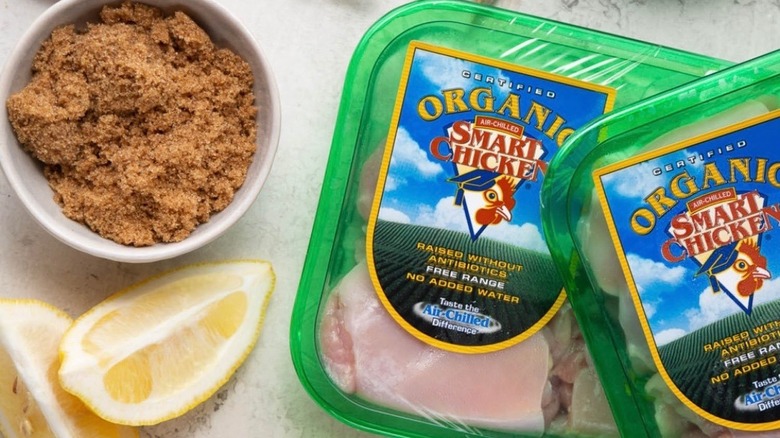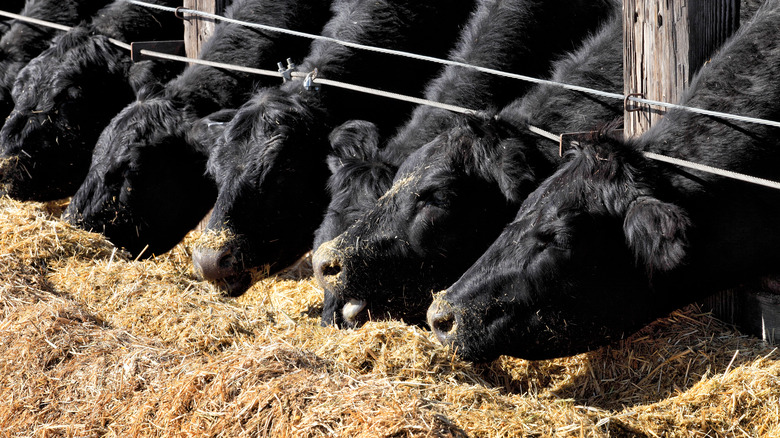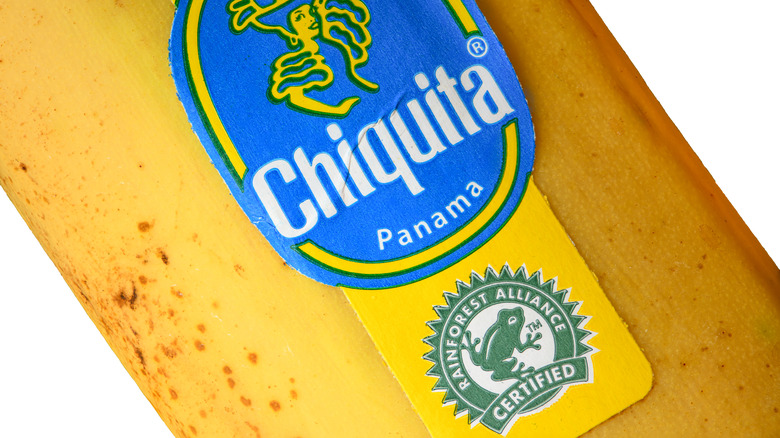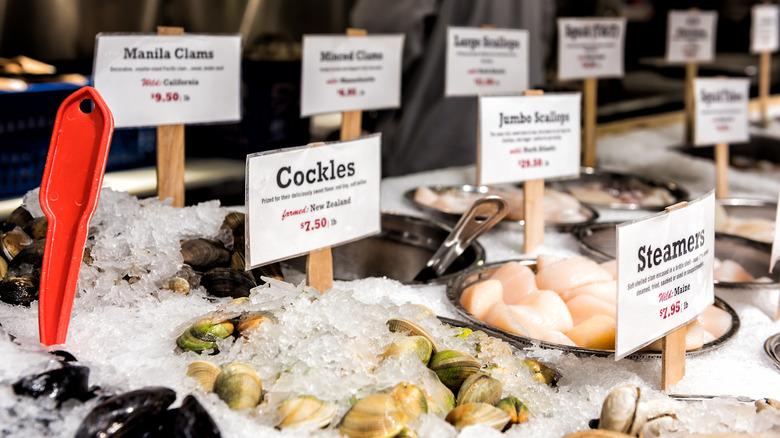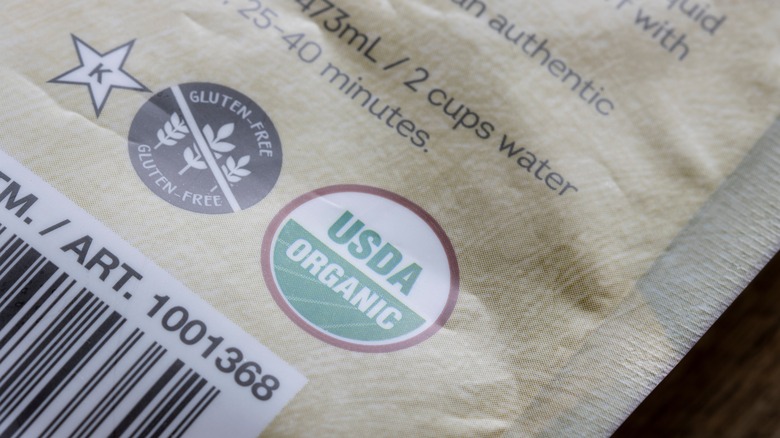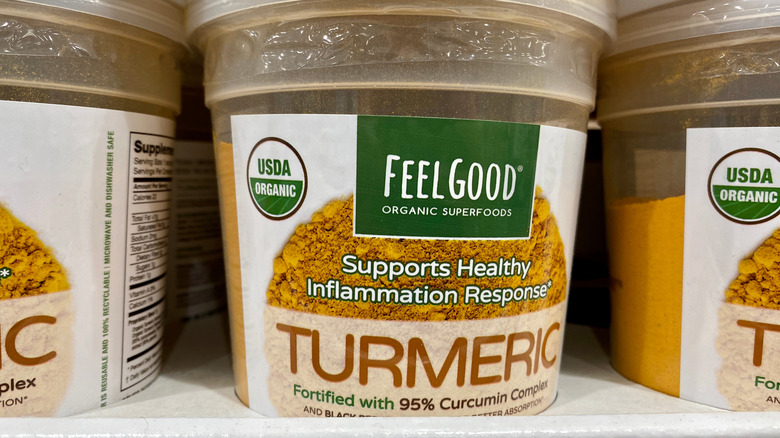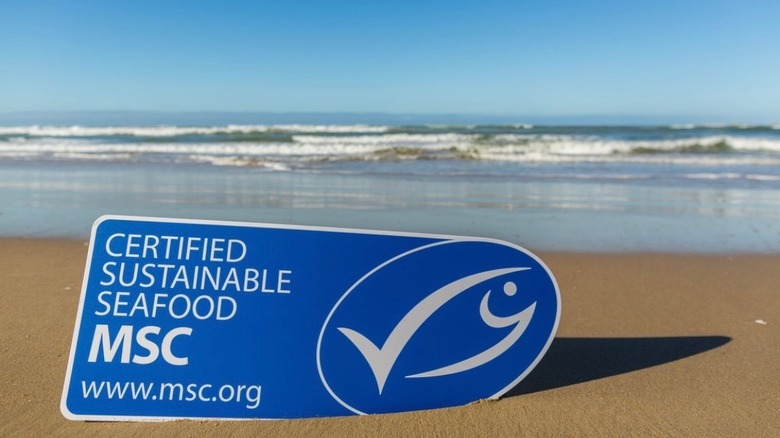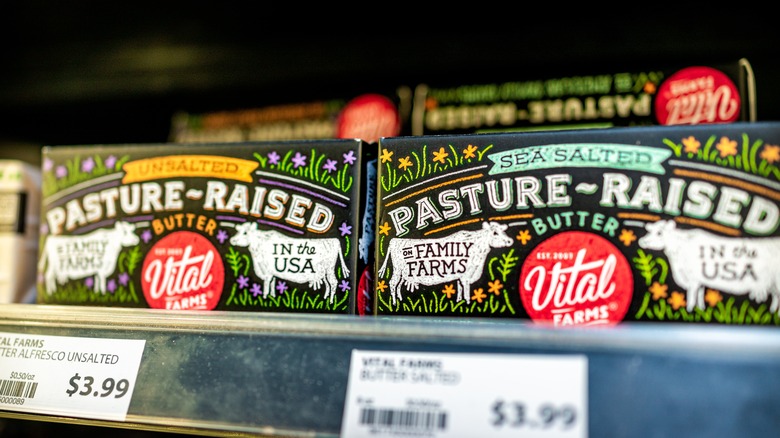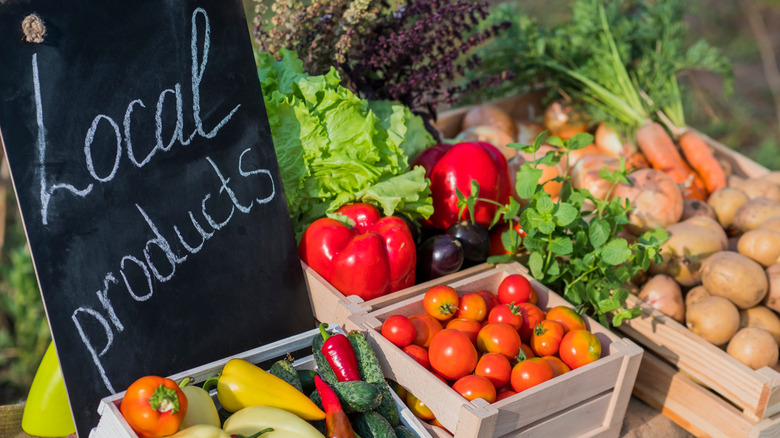Your Guide To Decoding The Different Terms On Organic Food Labels
When you think of "organic food," are you thinking of picturesque, romanticized images of farmers washing dirt off of carrots and turnips or Holstein dairy cows wandering across ample, lush pastures? If so, you wouldn't be the only one. The opaque public understanding of organic agriculture is why companies that offer "organic" food can profit so much from unwitting consumers.
We're not saying that ignorance about how organic food looks is entirely the fault of the consumer. The world of organic labeling, and food labels as a whole, is done without much consideration to consumers — and for specific reasons. After all, would you consider spending an extra premium on organic dairy if you knew the cows were kept in the same confined operation as the cows that make milk that sells for $2 less?
We're here to debunk some of the misunderstandings around organic food labels and terms and labels often associated with organic food. Next time you pick up a bundle of organic leeks or wonder if buying the more expensive organic butter is worth it, take a couple of seconds to see what the label tells you.
USDA Certified Organic
The USDA organic seal on products designates a product that has passed a rigorous review standard by the United States Department of Agriculture (USDA) to be considered organic. For a product to be designated with the USDA organic seal, it must have passed a set of standards, audits, and review through the USDA that addresses a variety of dimensions, including animal welfare, soil quality, pesticides, and weed control.
The USDA's organic approach is wholly prescriptive — meaning that it sets standards more so for what farmers cannot add to the soil, feed, and alike. These prohibited products include genetically modified organisms (GMOs), certain synthetic fertilizers, and irradiation (via the USDA). All products using the phrase "organic" or using the organic seal must have at least 95% of their ingredients certified organic under the USDA standards (via the USDA Agricultural Marketing Service).
100% Organic
"100% organic" is the most rigid USDA organic subcategory. The entire product has to be made of 100% organic ingredients and can display the USDA Organic seal (via the USDA). If you take granola as an example, all of the ingredients involved in its production, including oats, nuts, honey, and dried fruit, must be individually certified for the entire granola to be marketed as 100% organic. For meats, dairy, and egg products, this means that the respective animals involved in the food product are analyzed for their entire life cycle.
The animals must be fed 100% organic feed, managed without antibiotics or synthetic growth hormones, and raised on organic land that meets all USDA standards. Farmers ascribing to this production certification must uphold rigorous reporting and subscribe to frequent audits to ensure the standards are being met.
Made with Organic Ingredients
"Made with Organic Ingredients" is a common label for prepackaged, multi-ingredient products. For a product to be marketed and labeled as "Made with Organic Ingredients," it must contain at least 70% certified organic products. These products are not permitted to display the USDA organic seal, and the final product cannot be marketed as "organic." Instead, up to three ingredients or ingredient categories can be represented on the package (via the USDA). These might include "Made with Organic Whole Grains" or "Made with Organic Almonds."
So what about the other 30% of the ingredients? According to the USDA, these ingredients can be in a product marketed as "Made with Organic Ingredients" as long as those ingredients are produced with non-prohibited methods. For example, you won't find a "Made with Organic Ingredients" product that includes GMO corn.
Organic
"Organic" products must contain at least 95% organic ingredients; no more than 5% of the product ingredients can be non-organic ingredients. Organic products can include the USDA seal on the package (via the USDA). Non-agricultural ingredients like baking soda or pectin are specifically allowed for products marketed as organic.
If there is an agricultural product that cannot be found in an organic form, quantity, or quality, the USDA notes that the product can be substituted with a non-organic alternative. This includes ingredients like carrot juice color and fish oil.
Non-GMO Project Verified
We should first note that all products with the organic certification or "made with organic ingredients" claim are free of genetically modified organisms (GMOs). The Non-GMO Project label, which includes a butterfly, is a third-party certifying body that assesses both the product itself, as well as the process used to label, trace, and test products for the presence of GMOs (via the Non-GMO Project). If a product includes the Non-GMO project label, it may be a conventional agricultural product (meaning non-organic).
Antibiotic-Free
The livestock industry and antibiotics have a twisted history. Enter organic certification, and you have a whole new realm of complicated. As a whole, the organic movement prohibits the use of most antibiotics in livestock. However, there are always caveats and exceptions to this standard. If you buy organic animal products, you can rest assured that most synthetics are prohibited under USDA organic standards.
There are some protections for consumers in purchasing animal products treated with antibiotics in conventional agricultural products. The USDA Food and Drug Administration (FDA) released plans for voluntary phasing out certain types of antibiotics, especially those outlawed by other governmental identities like the European Union (via the USDA ERS). But, there is little enforcement for what products are labeled as "antibiotic-free."
Natural or All Natural
If a food product has the label "natural," "100% natural," or "made with natural ingredients," — run. There is no scientific grounding, standard, or verification for a "natural" product, nor is there a standard for what "natural" food even is (via the Food and Drug Administration). Natural and organic foods are different in this regard.
Although both the USDA and the FDA have described natural food as containing no synthetic additives, there has been very little enforcement over what the label means. For meat and poultry, the USDA requires an explanation of the moniker, but there isn't much beyond that stops companies from using the "natural" label frivolously for other foods (via the USDA).
Pesticide Free
The advent of pesticides was one of the most integral parts of farming globally. However, the advent of certain (not all) pesticides may carry detrimental impacts on human and ecosystem health. Like other standards under the USDA organic umbrella, the organic certification has prescriptive standards for what type of pesticides cannot be used on organic certified crops.
Conventional products do not have a set standard for what can or cannot be labeled as "pesticide-free" (via Greener Choices). Therefore, if you are seeking to reduce your contact with pesticides (granted, the contact you'll have through food is minimal), you should consider purchasing organic-certified food products.
rBST free
rBST is a synthetic recombinant bovine growth hormone, otherwise known as bovine somatropin, that increases milk production in dairy cattle. The Food and Drug Administration permits the use of rBST in conventional dairy operations, while USDA organic standards prohibit its use (via the Organic Valley Co-Op).
The exact health implications of rBST in dairy products are murky.e According to information from the American Cancer Society, the levels of rBGH in the milk of cows that have been treated with synthetic rBST are no different than cows that have not been treated. But, some consumer advocacy organizations have raised concerns about the long-term effects of rBST on cancer and chronic illness.
Real Organic Project seal
The Real Organic Project is a third-party certifying body that offers slightly different standards than the USDA's industrial organic complex. Real Organic Project-certified farms require pasture rotations for cows and chickens, prohibit hydroponics, and other standards that the USDA either does not address or permits under their organic certification (via the Real Organic Project). The Real Organic Project is still in its grassroots era, so it is more common to find organic products with USDA certification.
Cage-Free
"Cage-free" implies that laying hens are allowed to roam in a covered space, which is often a barn or poultry house, rather than kept in battery cages that limit motion and the ability of the birds to stretch their wings.
Eggs graded under the USDA system and marketed as "cage-free" are subject to twice-yearly audits (at minimum) by the USDA to ensure production processes are up-to-standard (via the USDA). Eggs certified under the USDA organic certification label must be cage-free and fed a 100% organic diet.
Humanely-Raised
According to the Humane Society of the United States, the phrase "humanely raised" has no weight or validity; these terms are self-defined by the producers. In contrast, the "Certified Humane" label is monitored by the non-profit organization Humane Farm Animal Care.
According to Consumer Reports, the Certified Humane label enforces standards, including training for employees on animal welfare, provision of "comfortable living conditions," or livestock-specific standards for mobility. As it stands, the Certified Humane label has more rigorous standards for animal welfare than the blanket USDA organic seal.
Fair Trade
Fair Trade USDA certifies everything ranging from dairy to flowers to seafood, but you are most likely to see the certification for products like chocolate, bananas, or coffee. The Fair Trade label focuses on several dimensions, including safe working conditions, environmental protection, and equitable pay for growers and producers (via Fair Trade USDA).
Fair Trade provides an integral stepping stone for what the USDA organic certification has been lacking — a devoted standard for the economic well-being, health, and safety of the people that produce our food.
Fed a vegetarian diet
Do you mean chickens aren't vegetarians? Not always, especially in the case of livestock grown for human consumption. Blood meal, slaughterhouse leftovers, and alike find their way into animal feed to increase micronutrients and protein. Organic products prohibit the addition of synthetic amino acids and slaughter by-products in certified organic feed (via ATTRA).
The only exception, per ATTA, is synthetic methionine for chickens to supplement soy or corn-based diets. According to Morning Chores, the USDA regulates all claims of eggs from chickens being fed a vegetarian diet as well.
Free-range
"Free-range" under the USDA poultry standard means that birds have access to the outdoors. This doesn't necessarily mean that the birds can go outside, and many producers just interpret this standard as applying a pop hole to allow the birds to stick their heads outside of the house (via Certified Humane).
There is no minimum for the amount of time the birds spend outside either — just the requirement that the birds cannot be housed in cages. By definition, USDA organic eggs and poultry are considered free-range because of the prohibition of cages and allotment of "access to the outdoors" — however insufficient.
USDA Process Verified
USDA Process Verified and Certified Organic are not synonymous. The USDA's process verification program (PVP) provides third-party auditing to companies that are looking to examine the language they use to market their food products and compare it to the actual certification processes that occur (via the USDA).
In essence, it's a form of internal accountability that the USDA's Agricultural Marketing Service validates. Organizations that adhere to the processes they say they do and are approved for can use the USDA's process-verified seal on their products.
Steroid and Growth Hormone Free
We first have to assess important rumors surrounding steroid use in agriculture. According to the USDA, the Food and Drug Administration regulates the use of steroids and hormones in agriculture. Some steroids are approved for use in beef cattle; none are permitted for use in poultry, dairy, veal, or pork (via the FDA).
So, you aren't paying for anything new if you see chicken wings with the "steroid-free" label. If you see the label on beef products, there's something to pay attention to. As expected, USDA organic products have a more prohibitory approach towards steroids in beef cattle (via Certified Humane).
Rainforest Alliance certified
The Rainforest Alliance is a non-profit certifying organization that addresses forestry-specific standards, including ecological well-being, anti-deforestation process, climate change mitigation, consideration of human rights, and the improvement of rural livelihoods. You may see products that carry both the organic label and ones with the Rainforest Alliance frog seal, but the two are separate entities entirely.
In the same vein, Rainforest Alliance-certified products don't always undergo the organic certification process. This doesn't mean that these agricultural products don't adhere to organic processes; it's no myth that the organic food process that it's expensive; since the organic certification process is so expensive and resource-intensive, many farms cannot justify the investment in the program.
Fresh
"Fresh" is a deceptive term used for food. It does not mean that food is more nutritious or of a higher quality than food without the "fresh" label. Rather, it's meant to imply that the food has received limited manipulation from the time it is harvested to when it is eaten.
Some foods, like apples, are covered with a wax coating during transit, while others are treated with an approved pesticide post-harvest. Do you consider both of these types of food as being "fresh?" That definition is totally up to you.
Gluten-free
The gluten-free label is especially important for folks with Celiac disease or gluten intolerance. The FDA defines a "gluten-free" product as one containing less than 20 parts per million (PPM). There is no official standard for foods with less than 20 ppm of gluten, and brands can use whatever terminology they see fit as long as the product contains below the gluten maximum.
The Gluten Intolerance Group's Gluten-Free Certification Organization (GFCO), the Celiac Support Association (CSA), and the Allergen Control Group offer independent certification programs for producers looking to market their goods as "certified gluten-free" (via Schaer).
Fortified
Fortification was an important era of food manufacturing. According to an article published by the National Institute of Health, fortification adds micronutrients like vitamin A, zinc, and iron into foods that may or may not have had them before processing. An example is breakfast cereal like Kellogg's Special K, which is fortified with vitamins B6, B12, B1, and beta-carotene.
In 2012, the USDA submitted a proposal to change the standard on fortification in organic products, claiming that only nutrients deemed "essential" by the FDA should be added to organic food (via the USDA Agricultural Marketing Service). "Non-essentials" would be prohibited in organic-certified food unless the product is listed on the allowed substances list. So far, food fortification is still legal under USDA organic certification.
Enriched
Enrichment draws many parallels to fortification — except for one major difference. Enrichment adds the nutrients back into food that was lost during processing. For example, some producers may introduce the B vitamins and minerals lost during the flour milling back into white bread (via Science World).
The relationship between enriched food and organic is the same as fortification; as long as the ingredients are listed on the approved list, producers can add the vitamins and minerals back in. Milk and flower are commonly enriched products.
Sustainably sourced
Sustainably sourced (or just "sustainable") is another buzzword used in the marketing of food products — most notably fish. Is sustainable the amount of fish harvested by one boat? Who decides how much fish caught from the ocean is sustainable? Currently, there aren't any rules about labeling a "sustainable" product.
As for "sustainable" meats and vegetables, how does the producer define sustainability, and what procedures are implemented to keep the company accountable to those standards? These questions are why having independent audits, either by a governmental or non-governmental organization, is important for consumer protection.
Marine Stewardship Council blue label
If you've been shopping for fish lately, you've probably seen the Marine Stewardship Council (MSC) blue label. The MSC certifies wild-caught fishing operations that ensure stocks are healthy, managed, and have a minimal impact on the ecosystem (via the MSC). The MSC doesn't certify purely aquaculture operations (fish farms).
Additionally, the USDA organic label currently does not certify aquaculture operations or wild-caught fisheries (via the Organic Trade Association). There has been minimal movement since to expand the USDA organic label to include either of these products, so consumers are recommended to search for the MSC label or follow information from the Monterey Bay Aquarium Seafood Watch Guide.
Pasture-raised
When it comes to beef and dairy, "pasture-raised" refers to the idea that the animals get a portion of their diet from managed pastures. This can include dried and stored forage, as well as receiving supplemental grain. This is not the same as "grass-fed," which means that the entire lifecycle of the animal is fed on grass (via Beetnik Foods).
A grass-fed cow can be kept indoors for almost all of its life as long as it is fed grass in the form of hay. For meat and poultry, producers must submit a claim to the USDA to state why their product is considered "pasture-raised." This audit only occurs once and does not require any sort of continued review or on-farm inspections (via Greener Choice).
Local
Local food is not always organic food — although it could be! Like other food labels, there is no standard definition for what local food is. "Local" can be tomatoes grown at a farm 10 miles away but in the same state, or it can mean food grown within a 200-mile radius (via SunLeaf Foods).
For many, purchasing food from local purveyors can increase the feeling of investing in one's community or a subliminal connectedness to the food system. However, smaller producers face numerous challenges in going through the organic certification process. The auditing, record keeping, and financial commitment of organic certifications are often major hurdles for producers that are already struggling to remain financially viable. As an informed consumer, the best thing you can do is ask your local producer about what kind of practices they employ — you might be pleasantly (or not so pleasantly) surprised.
